Integrated Parthenium Management
Integrated Parthenium Management
- What is Parthenium?
- How to identify it?
- How Parthenium spreads?
- Harmful effects of Parthenium?
- Integrated management of Parthenium
- Mechanical and manual methods
- Cultural management
- Legal and extension management
- By use of chemicals
- By use of biological control agent
- Use of competitive plants
- Management by way of utilization
What is Parthenium?
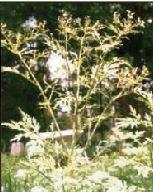 Parthenium hysterophorus L., commonly known as carrot weed, white top or congress grass in India, is a herbaceous, erect and annual plant belonging to the family Asteracae (compositae). It is most popularly known as gajar ghas due to its appearance like carrot plant.
Parthenium hysterophorus L., commonly known as carrot weed, white top or congress grass in India, is a herbaceous, erect and annual plant belonging to the family Asteracae (compositae). It is most popularly known as gajar ghas due to its appearance like carrot plant.
The origin of Parthenium is considered to be from Mexico, America, Trinidad to and Argentina.
After noticeable occurrence of Parthenium in Pune (Maharashtra) in 1956, it has spread like a wild fire throughout India. At present it has invaded about 35 million hectares of land in India.
It is a nuisance on road sides and railway tracks, vacant lands, wastelands, industrial areas, on the sides of open drainage system and irrigation canals besides invading agricultural crop.
How to identify it?
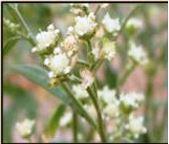 Parthenium leaves look like I carrot leaves hence it is called carrot weed or gajar ghas. It may attain a height of 1 to 1.5 meter.
Parthenium leaves look like I carrot leaves hence it is called carrot weed or gajar ghas. It may attain a height of 1 to 1.5 meter.
It is branched. Stems and leaves are covered with fine hairs. The flowers are white.
How Parthenium spreads?
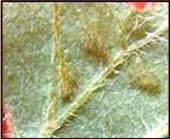
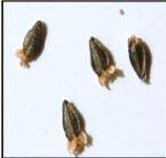 It mainly spreads through seeds. The weed has the potential of producing as high as 154,000 seeds/m2 and a single plant can produce about 15000 - 25,000 seeds.
It mainly spreads through seeds. The weed has the potential of producing as high as 154,000 seeds/m2 and a single plant can produce about 15000 - 25,000 seeds.
The seeds are very light in weight and easily carried or transported by wind, water or through various human activities.
Parthenium has the capacity to re-grow from the cut or broken parts. Its allelopathic effects coupled with the absence of natural enemies like insects and diseases are two important factors responsible for its rapid spread in India.
Harmful effects of Parthenium?
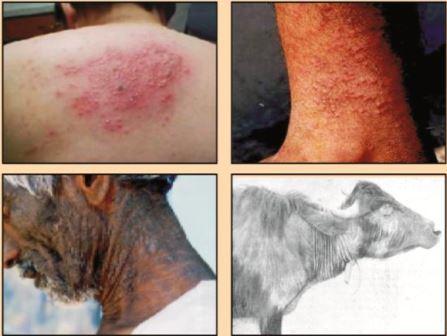 In general, parthenium is a poisonous, pernicious, problematic, allergic and aggressive weed posing a serious threat to human beings and livestock.
In general, parthenium is a poisonous, pernicious, problematic, allergic and aggressive weed posing a serious threat to human beings and livestock.
In India and Australia, this weed has been considered as one of the greatest source of dermatitis, asthma, nasal-dermal and nasal-bronchial types of diseases.
Besides ill effects, it also causes several other problems like blockage of common pathways and reduces the aesthetic values of parks, gardens and residential colonies.
Parthenium also infest every type of crop, orchards, plantations and forest. It severely reduces the crop productivity besides loss to biodiversity and environment.
Integrated management of Parthenium
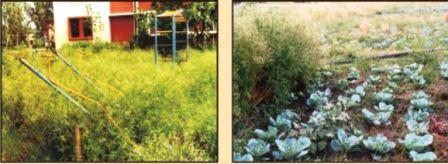 Ever since the weed became a menace in India and other countries, efforts are being made to manage the weed by different methods.
Ever since the weed became a menace in India and other countries, efforts are being made to manage the weed by different methods.
But so far, no single method has been proved satisfactorily as each method suffers from one or more limitations such as impracticability temporary relief, environmental safety high cost, etc.
Therefore, there is an urgent need to adopt an integrated Parthenium management approach by amalgamating all the methods together as and when applicable.
Mechanical and manual methods
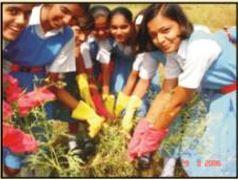 Uproot the parthenium before flowering during monsoon when soil is wet. As sensitive persons may be allergic to this weed, therefore, it will be better to wear gloves or use polythene bags in hands while uprooting the Parthenium.
Uproot the parthenium before flowering during monsoon when soil is wet. As sensitive persons may be allergic to this weed, therefore, it will be better to wear gloves or use polythene bags in hands while uprooting the Parthenium.
Parthenium is not a problem of single individual, mainly it is a problem of whole community. Therefore, there is need to motivate colony residents, workers in industry and large farms to up root the Parthenium in collective way.
Cultural management
Farmer should take fast growing crop like sorghum, Jowar and daincha to suppress the growth of Parthenium in their field.
Legal and extension management
The management of Parthenium was also tried in India through the legal act, first in Karnataka State. This act can be implemented at municipality or state level to prevent the spread of Parthenium.
By use of chemicals
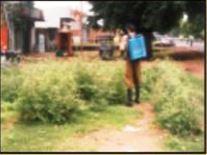 Parthenium in waste land can be controlled by use of glyphosate (1 to-1.5%) for total vegetation control but if grasses are to be saved, metribuzin (0.3 to 0.5%) or 2,4-D (2-2.5 kg a.i) can be used.
Parthenium in waste land can be controlled by use of glyphosate (1 to-1.5%) for total vegetation control but if grasses are to be saved, metribuzin (0.3 to 0.5%) or 2,4-D (2-2.5 kg a.i) can be used.
In different crops, the use of herbicides should be done only after consulting weed scientists because for different crops, different herbicides are required. Alaclor (2.0 kg a.i) can be used as pre-emergence to control Parthenium in soybean, rajmaha, banana and tomato crop. Metribuzin (0.50 to 0.75 kg a.i) can be used as pre-emergence just after sowing to control Parthenium in potato, tomato and soybean crop.
By use of biological control agent
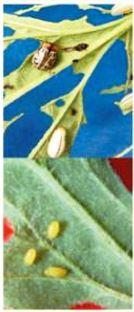 Biological control is the intentional manipulation of natural enemies by man for the purpose of controlling harmful weeds. Parthenium can be managed by its natural enemies like insects, fungi, nematodes, snails, slugs and competitive plants. Biological control is inexpensive and poses no threat to non-target organisms, environment and biodiversity. It is self-perpetuating and can spread on its own while other control measures require inputs periodically. It is easy to integrate with other control measures. Under the biological control programme, host specific bio agents from the native home of the weed are imported into other countries, where the weed had entered and became invasive
Biological control is the intentional manipulation of natural enemies by man for the purpose of controlling harmful weeds. Parthenium can be managed by its natural enemies like insects, fungi, nematodes, snails, slugs and competitive plants. Biological control is inexpensive and poses no threat to non-target organisms, environment and biodiversity. It is self-perpetuating and can spread on its own while other control measures require inputs periodically. It is easy to integrate with other control measures. Under the biological control programme, host specific bio agents from the native home of the weed are imported into other countries, where the weed had entered and became invasive
Based on well documented success by Mexican beetle, Zygogramma bicolorata Pallister (Coleoptera: Chrysomelidae), in other countries where they were introduced, beetle was imported in 1982 from Mexico to Bangalore. Detailed host-specificity tests under quarantine conditions confirmed the safety of Z. bicolorata to cultivated crops in the country. This beetle has been found effective against Parthenium. Therefore it should be released against Parthenium.
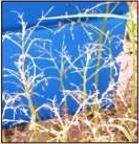 Beetles are off white or light reddish in colour with dark brown longitudinal markings on the elytra, measuring about 6 mm in length. Light yellow eggs are laid generally on ventral side of the leaves and hatch in 4-7 days. The beetle complets it’s life-cycle in 22-32 days. Insect completes 5-6 generations under field conditions.
Beetles are off white or light reddish in colour with dark brown longitudinal markings on the elytra, measuring about 6 mm in length. Light yellow eggs are laid generally on ventral side of the leaves and hatch in 4-7 days. The beetle complets it’s life-cycle in 22-32 days. Insect completes 5-6 generations under field conditions.
Both adults and larvae are capable to feed on parthenium. By continuous feeding on Parthenium, it gradually kill the weed. Newly emerged plants after first flush are very vulnerable to the attack of grubs and adults.

Use of competitive plants
Parthenium can also be managed by competitive plants like Cassia tora, Cassia sericea Tephrosia purpurea, Achyranthes aspera etc. But among these botanical, Cassia tora or C. sericea are widely used to replace Parthenium. The seeds of Cassia can be collected during October- November and should be broadcasted in April - May before monsoon on the predetermined area to be replaced.

Management by way of utilization
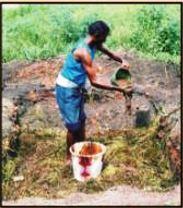 Parthenium can be used for several purposes. But it can most effectively be used in compost and vermi-compost making. The compost should only be prepared by pit system. In NADEP method, all the seeds of Parthenium are not killed. The Parthenium biomass should be buried in the pit in layers. On each layer, 5 kg dung slurry and 500 gram urea should be used. After filling the pit, it should be closed by the mixture of soil and dung. The compost prepared by Parthenium contains more nutrients than the compost prepared by dung only. Big plants having more fibrous stems and branched can be used to make particle boards and composites.
Parthenium can be used for several purposes. But it can most effectively be used in compost and vermi-compost making. The compost should only be prepared by pit system. In NADEP method, all the seeds of Parthenium are not killed. The Parthenium biomass should be buried in the pit in layers. On each layer, 5 kg dung slurry and 500 gram urea should be used. After filling the pit, it should be closed by the mixture of soil and dung. The compost prepared by Parthenium contains more nutrients than the compost prepared by dung only. Big plants having more fibrous stems and branched can be used to make particle boards and composites.
শেহতীয়া উন্নীতকৰণ: : 5/10/2022
This topic provides information about Mexican beet...
This topic contains the information related to Bio...
